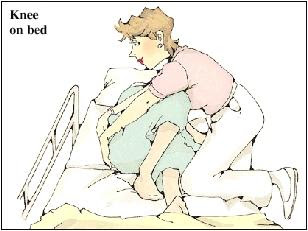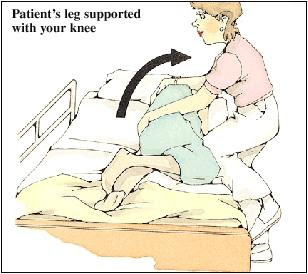
Turning Patient Over (Repositioning) in Bed
Repositioning can be difficult for a bedridden patient at home. Usually one or two people can turn a patient safely. Here are some helpful steps for repositioning:
- Tell the patient what you are going to do.
- Encourage the patient to help you if possible.
- Wash your hands.
- Stand close to the patient and ask the patient to look towards you.
- Move the patient to the center of the bed by pulling the bed sheet, so the person is not at risk of rolling out of the bed.
- The patient’s bottom arm should be stretched towards you. Place the person’s top arm across his/her chest.
- Cross the patient’s upper ankle over the bottom ankle.
- Adjust the bed to a level that reduces back strain for you.
- Make the bed flat.
- Place one of your hands on the patient’s shoulder and your other hand on the hip.

- Standing with one foot ahead of the other, shift your weight to your front foot as you gently pull the patient’s shoulder toward you. Then shift your weight to your back foot as you gently pull the patient’s hip toward you.

- When the patient is in the right position, make sure the patient’s ankles, knees, and elbows are not resting on top of each other.
- Make sure the head and neck are in line with the spine.
- Return the bed to a comfortable position with the side rails up.
- Check with the patient to make sure the patient is comfortable. Use pillows as needed.
- Small pillow under the person’s head.
- Small pillow lengthwise under the calf of the weak leg.
- Place a pillow at the back to prevent rolling.
- Place a pillow in front to keep the arm at the same height as the shoulder joint.
- Change the person’s position every 2 hours. She/ He may not be aware of pressure, pain or skin irritation. It is not necessary to change position frequently for patient at the very end of life.

- Doctor Name
Version 1. February 1, 2019
